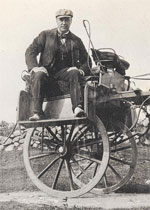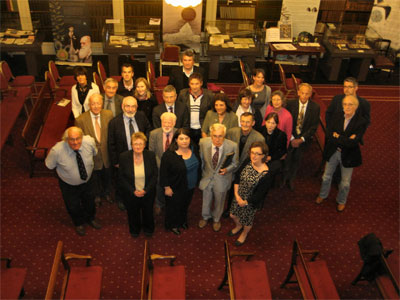News Archive
Appeals
Heron-Allen Society/Royal Irish Academy Survey
of Clare Island Seminar
Friday 2nd October 2009
Academy House,
19 Dawson Street, Dublin

Programme
- 12:00
Light lunch for the Heron-Allen Society at the Academy with Committee Members of the New Survey
of Clare Island - 1:00-2:00
Timothy Collins talk: 'The Clare Island Survey: 100 researchers, six nationalities, and an outstanding landmark in Irish natural history' - 2:00-2:30
Tour of Library exhibition: 'Darwin, Praeger and the Clare Island Surveys' and viewing of Heron-Allen Society Journals and expedition items - 2:30-3:15
Timothy J. McCann: 'The singular life of Edward Heron-Allen' - 3:15-3:30
Coffee - 3:30-4:15
John E. Whittaker: 'Heron-Allen's travel journals from Clare Island' - 4:30
Close
Report
JOINT MEETING WITH THE ROYAL IRISH ACADEMY

Thirteen people, either members of the Heron-Allen Society or their family and friends, made the trip to Dublin for the Royal Irish Academy seminar on the first Clare Island Survey, on 2 October. It was an exciting time to be in Dublin, as it was the day of the second vote on the Lisbon Treaty. The visit also coincided with a demonstration by taxi drivers, which blocked O'Connell Street, and meant that Ivor's journey in from the airport took an hour and a half.
Most of the party stayed in the Riverside Hotel - Temple Bar - the rather Bohemian and very lively part of the city. The location was noisy, but it did mean that there was a great variety of restaurants and bars near at hand. As we set off on the first evening to find a suitable restaurant, the sound of music and laughter led us just across the road to a little square, where a trick cyclist was performing to an appreciative audience, and where we found an Italian restaurant tucked into a basement. The meal there was excellent, though the consumption of wine was rather frightening. I don't think I have ever had a meal where we were on the second bottle of wine before we had even ordered. The micropalaeontologists proved to be amazing bibeurs.
The Friday was the day of the seminar, where we were joined by other members already in Ireland, and the Royal Irish Academy had kindly provided a buffet lunch for the whole party. The Academy building is a beautiful Georgian house in Dawson Street, on the back of which is a magnificent 19th. Century library and lecture room. Our hosts for the lunch were the committee of the new Clare Island Survey, and we were welcomed by Professor Martin Steer, the Chairman.
After lunch we went into the lecture room and heard an excellent talk by Dr. Tim Collins of the University of Galway about the background to the first Clare Island Survey of 1909-1911. He terace3d the development of amateur natural history clubs which attracted people of all disciplines, of all ages and both sexes. As well as the scientific interest, an added attraction of the clubs was that they provided a rare opportunity for the sexes to meet informally. The individual Field Clubs, as they were known, came together for their Triennial Unions, or conferences. These provided an opportunity for am area to be examined by natural historians of all disciplines, and from this grew the idea of a complete survey of a particular area.
Clare Island was chosen because it was of a manageable size, reasonably easy to access and had accommodation available. Dr. Collins illustrated his talk with photographs of Clare Island, which complemented those in EH-A's holiday journal of his time on Clare Island, which Ivor had brought with him, as well as those in EH-A's own interleaved copy of his and Arthur Earland's Clare Island report, which John Whittaker had brought from the Natural History Museum in London.
Dr. Collin's talk was followed by Tim's on EH-A himself and his many interests. The Royal Irish Academy people listening were amazed as Tim explained EH-A's many and various talents - they had previously only known him as a foraminiferist.
After Tim's talk, there was a break for tea, and a chance to look at the exhibition that they Royal Irish Academy had put on in the Library about the Clare Island Survey. Tea was followed by John Whittaker's excellent and idiosyncratic talk based on EH-A's holiday journals, "a scientific expedition with pretty girls". The pretty girls in question were Muriel Murray and her cousin Inez, teenagers who were staying on Clare Island when EH-A was there, and who feature in several of his photographs.
Following the talks and the questions, the Royal Irish Academy staff produced a "goody bag" for everyone, with a copy of their booklet about the Clare Island Survey. Everyone concerned with the Survey and the RIA, especially Siobhan Fitzpatrick, the Librarian and members of the Library staff, Petra Schnabel, her deputy; Gilly Clarke, our contact person, and Roisin Jones, could not have been more friendly and welcoming, and it was a fascinating and memorable day. Hopefully it marked the start of a very fruitful and enjoyable co-operation. I am sure that many of us who enjoyed such an interesting time in Dublin will be hoping to follow it with a trip to Clare Island in 2011.
For the rest of the weekend, Dublin offered a wide variety of things to do and see. Tim and I spent some time on a busman's holiday, doing research in the National Library of Ireland, and also visited the Lane Gallery, the Irish Writer's Museum and the National Gallery, and attended a beautiful sung Latin Mass in the Pro-Cathedral. Others visited Trinity College and the Book of Kells; the Chester Beatty Library and the Guinness Museum. 'The Duke' off Grafton Street was a useful and agreeable meeting point, becoming our "local" for the week-end. It was there that those of us still in Dublin on the Sunday lunchtime met and enjoyed a substantial lunch before making our ways to the airport for the flight home.
Alison McCann
